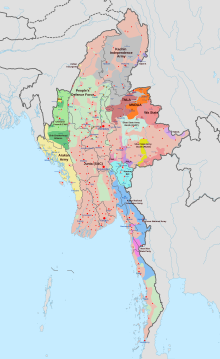
Back الصراع الداخلي في ميانمار Arabic Conflictu armáu en Birmania AST মিয়ানমারে অভ্যন্তরীণ সংঘাত Bengali/Bangla Conflicte armat birmà Catalan Bewaffnete Konflikte in Myanmar German Conflicto armado interno de Birmania Spanish درگیری میانمار Persian Conflit armé birman French म्यान्मार में आन्तरिक संघर्ष Hindi Konflik internal di Myanmar ID
| Myanmar conflict | |||||||
|---|---|---|---|---|---|---|---|
 Military situation in Myanmar as of 28 May 2024[update]. Areas controlled by the Tatmadaw are highlighted in red. For a live map, see here. | |||||||
| |||||||
| Combatants | |||||||
|
Ethnic armed organisations[a] | ||||||
| Commanders and leaders | |||||||
| Min Aung Hlaing | Duwa Lashi La | ||||||
| Units involved | |||||||
|
| Various (full list) | ||||||
| Strength | |||||||
| Total number of fighters unknown[b] | |||||||
| Casualties and losses | |||||||
|
180,000+ killed[c] 600,000–1,000,000 internally displaced | |||||||
Insurgencies have been ongoing in Myanmar since 1948, when the country, then known as Burma, gained independence from the United Kingdom.[6][7] It has largely been an ethnic conflict, with ethnic armed groups fighting Myanmar's armed forces, the Tatmadaw, for self-determination. Despite numerous ceasefires and the creation of autonomous self-administered zones in 2008, armed groups continue to call for independence, increased autonomy, or federalisation. It is the world's longest ongoing civil war, spanning almost eight decades.[8][9][10]
In 1940, during World War II, Burmese intellectuals formed the Thirty Comrades, who later established the Burma Independence Army (BIA) to fight against the Allies. Aung San led the State of Burma, switching allegiance to the Allies in mid-1944. Post-war negotiations led to Burma's independence in 1948, but tensions arose as the Panglong Agreement promising autonomy to ethnic minorities, was not honored after Aung San's assassination. This period saw the rise of the Communist Party of Burma and the Karen National Union (KNU).
In 1962, General Ne Win led a coup, establishing a military junta and refusing to adopt a federal system, leading to increased insurgencies. The Communist Party of Burma (CPB) and various ethnic groups, including the Kachin Independence Army and Karen National Liberation Army, took up arms against the government. Ne Win's regime faced internal dissent and growing insurgencies throughout his rule, culminating in the 8888 Uprising in 1988, which was violently suppressed by the military.
Following the uprising, the military established the State Law and Order Restoration Council (SLORC), later renamed the State Peace and Development Council (SPDC). The SPDC faced insurgencies and civil unrest, including the rise of the Arakan Rohingya Salvation Army (ARSA) in the 2010s. The situation escalated further with the 2021 military coup, led by Min Aung Hlaing, which deposed the civilian government and led to widespread protests and renewed insurgencies, particularly in ethnic minority regions like Kachin State, Kayah State, and Kayin State.
- ^ "Ethnic armed organisations' conference commences". Government of Myanmar. 26 July 2017. Archived from the original on 1 February 2021. Retrieved 8 February 2022.
- ^ IISS 2021, pp. 285–287.
- ^ Hein, Ye Myo. "Myanmar's Military Is Smaller Than Commonly Thought — and Shrinking Fast". United States Institute of Peace. Retrieved 12 April 2024.
- ^ Cite error: The named reference
PERI_20Jul11was invoked but never defined (see the help page). - ^ Cite error: The named reference
ACLED_dashwas invoked but never defined (see the help page). - ^ Head, Jonathan (31 January 2023). "Myanmar: Air strikes have become a deadly new tactic in the civil war". BBC News. Retrieved 18 September 2023.
- ^ Malerba, Andre; DeCicca, Lauren (8 November 2013). "In pictures: A ceasefire in Myanmar?". Al-Jazzera. Retrieved 18 September 2023.
- ^ Miliband, David (12 December 2016). "How to Bring Peace to the World's Longest Civil War". Time. Archived from the original on 13 May 2020. Retrieved 11 March 2019.
- ^ Slow, Oliver (26 April 2018). "Fighting in Kachin Highlights Myanmar Civil War Worries". VOA. Archived from the original on 24 July 2018. Retrieved 11 March 2019.
- ^ Kaicome, Jittrapon (8 February 2019). "Marking 70 Years of War in Myanmar". The Diplomat. Archived from the original on 30 December 2019. Retrieved 11 March 2019.
Cite error: There are <ref group=lower-alpha> tags or {{efn}} templates on this page, but the references will not show without a {{reflist|group=lower-alpha}} template or {{notelist}} template (see the help page).